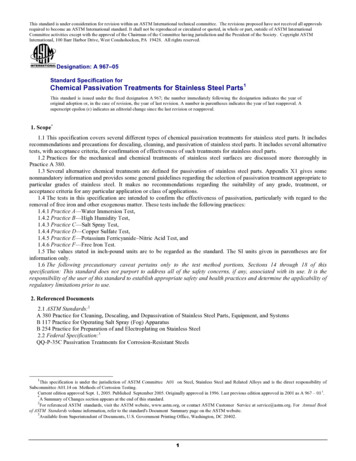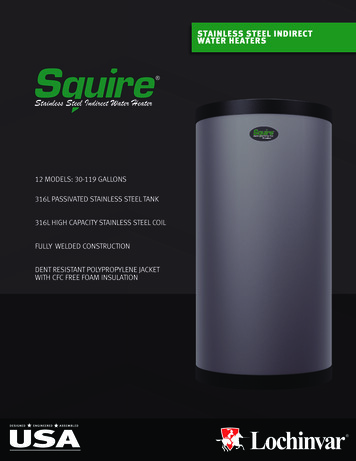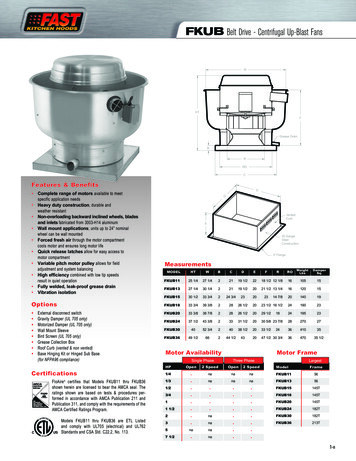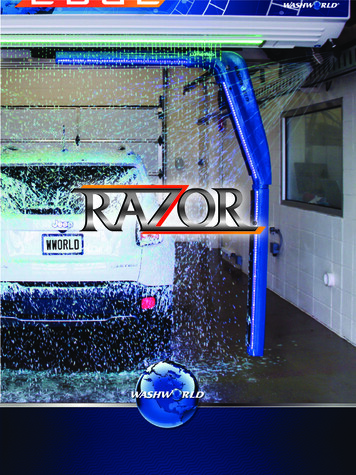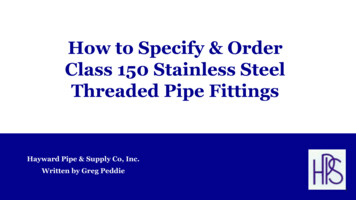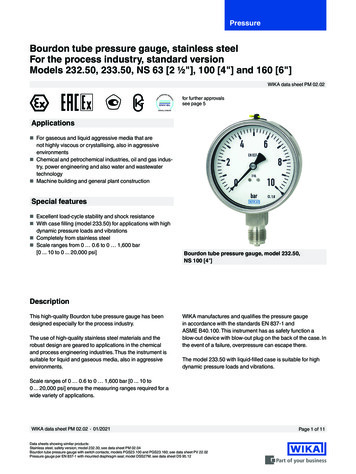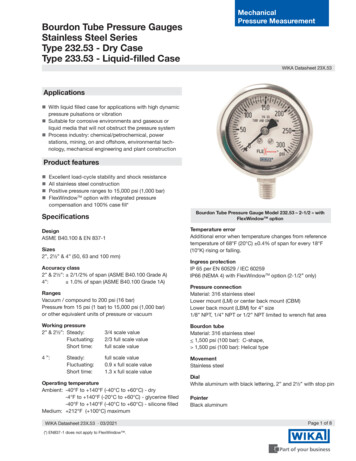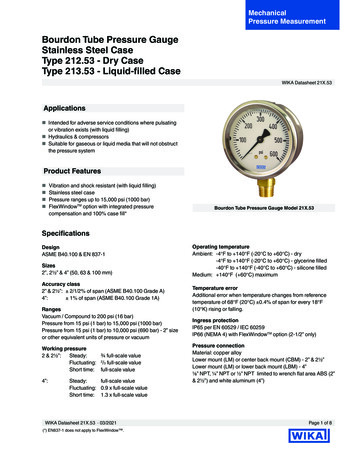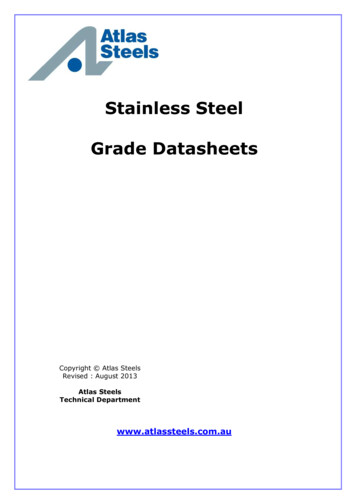
Transcription
METAL FINISHING SOLUTIONS BEYOND THE SURFACEPASSIVATION OF STAINLESS STEEL
PASSIVATION OF STAINLESS STEELPassivation of Stainless SteelGetting the Properties You've Paid Forby Dan Englebert, Vice President Technical ServicesImagineering Enterprises, Inc.The conversation usually starts out something like this: “Hey, this is Joe from Joe'sMachine Shop. We've got a job in here we're working on and the customer wants us tohave some kinda passivate coating something-or-other. You guys do that? How thick isthat stuff? Is that like some kinda plating or paint or something? What color is it? Howmuch tolerance should I allow for it?” Usually, the opening statement ends with aphrase like, “I don't even know why they need it. What's the point of using stainlesssteel if your gonna put some kinda coating on it anyway?”The fact of the matter is, “Joe” is not the exception. Many machine shops, purchasingagents, and engineers alike are somewhat in the dark when it comes to the relationshipbetween corrosion resistant (stainless) steel and chemical passivation. Even among themetal finishing community, there is some disagreement about the theory behind theprocess of chemical passivation. Some believe it is effective because it is a cleaningprocess. Others credit the enhanced corrosion resistant properties to the thin,transparent oxide film resulting from chemical passivation. Regardless of the argument, the bottom line is, it works! Verification tests, including copper sulfate immersion,and accelerated corrosion tests, such as salt spray, high humidity, and water immersion,undisputedly confirm the effectiveness of chemical passivation. Advanced material engineers in aerospace, electronics, medical, and similar high-tech industries have utilizedchemical passivation for many years. Their applications demand the maximum performance from components manufactured from corrosion resistant (stainless) steels, andthey realize that passivation is one of the most effective methods of achieving thedesired results.What is Passivation?According to ASTM A 380, passivation is “the removal of exogenous iron or iron compounds from the surface of a stainless steel by means of a chemical dissolution, mosttypically by a treatment with an acid solution that will remove the surface contaminationbut will not significantly affect the stainless steel itself.” In addition, it also describes passivation as “the chemical treatment of a stainless steel with a mild oxidant, such as anitric acid solution, for the purpose of enhancing the spontaneous formation of the protective passive film.”In layman's terms, the passivation process removes “free iron” contamination left behindon the surface of the stainless steel as a result of machining and fabricating processes.These contaminants are potential corrosion sites which, if not removed, result in premature corrosion and ultimately result in deterioration of the component. In addition, the
PASSIVATION OF STAINLESS STEELpassivation process facilitates the formation of a very thin, transparent oxide film, whichprotects the stainless steel from “selective” oxidation (corrosion). So what is passivation? Isit cleaning? Is it a protective coating? In my opinion, it is a combination of both!How is the Passivation Process Performed?The process typically begins with a thorough cleaning cycle. It is intended to removeoils, greases, forming compounds, lubricants, coolants, cutting fluids, and other undesirableorganic and metallic residue left behind as a result of fabrication and machiningprocesses. General degreasing and cleaning can be accomplished by a variety of commonly accepted methods, including vapor degreasing, solvent cleaning, and alkaline soaking.After removal of the organic and metallicresidues, the parts are placed into theappropriate passivation solution. Althoughthere are many variations of passivatingsolutions, the overwhelming choice is stillthe nitric acid based solutions. Recently,there has been substantial research performed to develop alternative processesand solutions that are more “environmentally friendly,” yet equally effective. Althoughalternative solutions containing citric acidand other types of proprietary chemistryare available, they have not been aswidely accepted commercially as nitricacid based solutions.TWO-HOUR salt spray test per ASTM B-117.With passivation on the left and without onthe right.The three major variables that must be considered and controlled for the passivationprocess selection are time, temperature, and concentration. Typical immersion timesare between 20 minutes and 2 hours. Typical bath temperatures range between roomtemperature and 160 F. Nitric acid concentrations in the 20% to 50% by volume rangeare generally specified. Many specifications include the use of sodium dichromate inthe passivation solution, or as a post passivation rinse, to aid in the formation of achromic oxide film. Careful solution control, including water purity, ppm (parts permillion) of metallic impurities, and chemical maintenance, is crucial for success.The type of stainless steel being processed is the determining factor when selectingthe most effective passivation process. Bath selection (time, temperature, and concentration) are all a function of the type of alloy being processed. A thorough knowledgeof the material types and passivation processes is paramount to achieving the desiredresults. Conversely, improper bath and process selection and/or process control willproduce unacceptable results, and in extreme cases, can lead to catastrophic failure,including extreme pitting, etching and/or totaldissolution of the entire component.
PASSIVATION OF STAINLESS STEELEquipment and PrecautionsPassivation should only be performed by trained, experienced technicians familiar withthe potential hazards associated with the science. Safety practices must be fully understood when handling passivation chemicals. Special boots, gloves, aprons and othersafety equipment must be utilized. Tanks, heaters and ventilation, as well as basketsand racks, must be appropriately engineered to perform the process. Iron or steel partsor equipment must never be introduced to the process, or the results can be devastating! Furthermore, in order to comply with EPA requirements, the necessary water andair permits and treatment capabilities must be in place. The days of the “mom-and-pop”shops performing passivation in a stone crock in the back corner of the shop are diminishing, due to safety and environmental concerns.Specifications and Verification TestingThere are a few generally accepted industry specifications available for reference whenchoosing a passivation process. They offer time, temperature, and concentration information, and subsequent testing requirements to validate the effectiveness of the process.Many large corporations have developed internal specifications to control their uniquerequirements regarding passivation and verification testing. Regardless of the situation,it is usually prudent to reference a proven procedure when requesting passivation. Byreferencing a specification, you don't have to “reinvent the wheel,” and by taking advantage of the past experiences of others, both successes and failures, you can eliminatemuch of the guesswork that would otherwise accompany a new process.Although recently cancelled, the most commonly referenced industry specificationsregarding passivation are Fed. Spec. QQ-P-35C, which is now superseded by ASTMA-967, and ASTM A-380. All three are well written, well defined documents which provide guidance on the entire process, from manufacturing to final testing requirements. Ifyou're not sure what you need, they can be referenced in full, or selectively. The testingrequirements can be utilized or waived, depending upon the individual situation.One of the most commonly specified verification tests is the copper sulfate test.Passivated parts are immersed in a copper sulfate solution for 6 minutes, rinsed, andvisually examined. Any copper (pink) color indicates the presence of free iron, and thetest is considered unacceptable. Other validation tests include a 2 hour Salt Spray or24 hour high-humidity test. These tests are performed by placing passivated parts ina highly controlled chamber which creates an accelerated corrosive environment. Aftersubjecting the test pieces to the corrosive atmosphere for the prescribed exposureperiods, the parts are removed and evaluated. Although results can be somewhatsubjective, ASTM B-117 is an excellent reference in determining acceptability. It isimportant to note that each of the test methods mentioned have different advantagesand limitations. Care should be taken to select the appropriate test methods, based onalloy type and end use environment.
PASSIVATION OF STAINLESS STEELMachining and Heat Treating TechniquesPerhaps the most overlooked variable in the entire passivation equation is the negativeimpact of poor machining and heat treating practices. All too often, gross contaminationintroduced during manufacturing and/or thermal processes leads to unacceptable testresults. The following practices will reduce gross contamination during manufacturingand increase the chances of successful passivation and test results:Stainless steel parts are supposed to berust - resistant.So how does this happen?* Never use grinding wheels, sanding materials, or wire brushes made of iron, ironoxide, steel, zinc, or other undesirable materials that may cause contamination of thestainless steel surface.* The use of carbide or other non-metallic tooling is recommended whenever possible.* Grinding wheels, sanding wheels, and wire brushes that have been previously usedon other metals should not be used on stainless steel.* Use only clean, unused abrasives such as glass beads or iron-free silica or alumina sand for abrasive blasting. Never use steel shot or grit, or abrasives which havebeen used to blast other materials.* Thorough cleaning prior to any thermal processing is critical! Stress relieving,annealing, drawing, or other hot-forming processes can actually draw surface contaminants deeper into the substrate, making them almost impossible to remove during passivation.* Care should be taken during all thermal processes to avoid the formation of discoloration (oxides). Passivation is not designed to remove discoloration, and will not penetrate heavy oxide layers. In extreme situations, additional pickling and descaling operations are required prior to passivation to remove the discoloration.Controlled atmosphere ovens are highly recommended for all thermal processes toreduce airborne contamination and prevent oxides from developing.
PASSIVATION OF STAINLESS STEELConclusionsSo how do you get “the performance you'vepaid for” from high-dollar stainless steelalloys? It really boils down to a basic understanding that the passivation process is bothan art and a science, and that machining,fabricating, and heat treating practices cansubstantially affect the corrosion resistanceof the component. It's a well known fact thatpassivation will enhance the corrosionresistance of stainless steels, but to realizethe maximum performance from these hightech alloys, all parties involved with manufacturing must understand their responsibility in maintaining the integrity of the materialthroughout the process.Copper Sulfate test per MIL-STD-753.With passivation on left and withouton right.About the Author:Dan Englebert is the Vice-President, Technical Services at Imagineering Enterprises,Inc., a metal finishing and consulting firm located in South Bend, Indiana. TheQS9000/ISO 9002 certified company was founded in 1959 and is recognized globally asan Electroless Nickel Plating expert source. Imagineering is a member of the NationalAssociation of Metal Finishers (NAMF) and the Indiana Association of Metal Finishers(IAMF). Englebert is a member of the American Electroplaters and Surface FinishersSociety (AESF) and the National Association of Corrosion Engineers (NACE).References1. ASTM A 380 - 96 Standard Practice for Cleaning, Descaling, andPassivation of Stainless Steel Parts, Equipment, and Systems* ASTM Committee A-1 on Steel, Stainless Steel, and Related Alloys* ASTM Committee on Standards100 Barr Harbor DriveWest Conshohocken, PA 194282. Fed. Spec. QQ-P-35C October 28, 1988 Passivation TreatmentsFor Corrosion Resistant Steel* CANCELLED April 4, 1997* SUPERSEDED by ASTM A 967 - 96
PASSIVATION OF STAINLESS STEEL3. ASTM A 967 - 96 Standard Specification for ChemicalPassivation Treatments for Stainless Steel Parts* ASTM Committee A-1 on Steel, Stainless Steel, and Related Alloys* ASTM Committee on Standards100 Barr Harbor DriveWest Conshohocken, PA 194284. ASTM B 117 - 95 Standard Practice for Operating Salt Spray(Fog) Apparatus* ASTM Committee G-1 on Corrosion of Metals* ASTM Committee on Standards100 Barr Harbor DriveWest Conshohocken, PA 19428
ASTM A 967 - 96 Standard Specification for Chemical Passivation Treatments for Stainless Steel Parts * ASTM Committee A-1 on Steel, Stainless Steel, and Related Alloys * ASTM Committee on Standards 100 Barr Harbor Drive West Conshohocken, PA 19428 4. ASTM B 117 - 95 Standard Practice for Operating Salt Spray (Fog) Apparatus * ASTM Committee G-1 on Corrosion of Metals * ASTM Committee on .
